Feature Interview with Adam Clayman
September 2003
Adam Clayman was one of the participants in the GolfClubAtlas.com New Mexico 2003 fall gathering. This is his story.
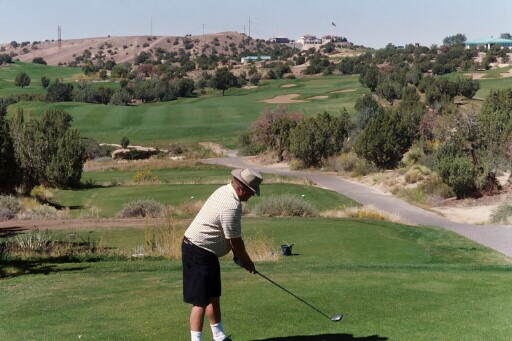
Adam Clayman prepares to drive on the current 18th at Pinon Hills.
In the ‘who are you guys’ thread you describe yourself as a ‘nobody from Chicago.’ How did you find the Game?
I was fortunate to grow up four doors away from the first public course opened west of the Alleghenies, Jackson Park G.C. built in 1897, on the south side of Chicago. One day, after jumping the fence and hanging around the 7th tee, a rather large Bahamian gentleman, who introduced himself only as Mr. Thompson, offered me fifty cents to caddie for him. I quickly took him up on the offer, as any seven-year old would. In our group were three elderly women whom he was paired with. He handed me his bag and off we went.
While approaching the 7th green and instructing me on the finer merits of the game, we inadvertently got ahead of our three playing partners. One of them hadn’t noticed it either, and reared way back and proceeded to hit her shot. In what had to be one of the most direct hits this nice lady had probably ever had, it ricocheted off the back of Mr. Thompsons skull. I was in shock, waiting for him to drop, but it completely unfazed Mr. Thompson. He motioned to the ladies he was O.K. and back to golf we went! It was then, I knew I loved this most unusual game.
In 1981 I became an independent floor broker and trader at the Chicago Mercantile Exchange. Life was hectic and after two years I started trading less and less to the point that after an hour a day, win or lose, it was a cinch that the only place you could find me was any course that was close and had a tee time. I traded a ticker tape for the weather channel; speculating not on markets but where the rain wasn’t going to be.
When did you first realize you had an appreciation for Golf Course Architecture?
I had thoroughly enjoyed the game of golf as a recreational golfer since 1983. In 1989 a friend started taking agronomy classes. Living vicariously, I started to slowly notice and appreciate individual features and was simultaneously gaining knowledge about turf science. My friend and I started driving north to Wisconsin and experienced the opening season of Blackwolf Run. We were repeatedly exposed to the original River-Valley course which Pete Dye had called ‘the most natural setting for golf ‘ he had ever seen. I found the flow and variety of features, combined with the character of that land, made the two-and-a-half-hour drive to get to Kohler, more than justified. Sadly, it was the loss of that original golf course (to its present configuration) where I first recognized the concept of a course having a ‘soul’ or more accurately, a lack thereof. Dont get me wrong, the newer holes built on the River Course are all good and most are great golf holes. I personally love the 8th ‘Hells Gate’ and #9 is one of the most beautiful settings, for an option filled hole, I have ever seen. But there is a palpable difference between the brute strength inherent in the new series of holes and the depth and breath of flow that comprised most of what was the original courses soul.
When that same friend started building his own par 3 course, my interest was fully ignited.
How did that appreciation grow?
Since I was doing most of my trading away from the floor, I leased out my seat, gave away most of my belongings and packed up my Honda Accord and moved to Los Angeles in 92. Golfing infrequently I am amazed at the many memories from those few days in Los Angeles. i.e. Rancho Parks monument on the 18th tee dedicated to junior golfers everywhere graphically showing every shot of Arnold Palmers 12, carded on the final hole of an early 60s L.A. Open. I enjoyed my many trips around the nine-holer ‘Roosevelt’, in Griffith Park (Bendelow?). Thanks to the good graces of another friend, I golfed at Wilshire C.C. being invited back was somewhat of a pleasant surprise since I had stripped down to my underwear, twice, to blast out of their Barrancas.
When a friend told me her mother was terminally ill she asked me if I would consider moving in with her Dad, in San Jose. One morning I awoke pre-dawn wide eyed, an urge came over me and I hopped in the car and started for the Monterey Peninsula. Upon first light from lifting fog, I began to see signs ‘Parking for AT&T at Ft. Ord’. My spirits sank, realizing I was on the Peninsula for the first time, without a tee time and it was tournament Thursday. I found a Dennys Restaurant, that happened to have what seemed like every golfer in the world in it, called a friend (who grew up in the Bay area) and asked him for advice on where to golf. I called Del Monte but they had a tournament, when I asked Pacific Grove Municipal if they also had a tournament, the person on the other end of the phone said ‘ Yes, a seniors at 10 oclock but if you come now I can get you off the back’. Realizing I was on the Peninsula, I timidly asked ‘How much will that be?’ the reply was ‘$13.50’. I said excitedly ‘heres where I am, how do I get to where you are?’ That day the ocean had some huge waves and I golfed 27 holes at P.G.. Driving back to San Jose that evening I was as satiated as any golfer could be, ever. After sixteen months of golfing throughout Nor Cal, I found hidden gems that were affordable on weekdays, i.e. Tilden Park, Lake Chabot, Stevinson Ranch and Summit Point, among others. Even so, I found myself making it to the Monterey peninsula as often as three times a week, obviously preferring the golf values found there.
When friend, Ed Placha, drove across the country in late May of 96, I flew to Albuquerque and we drove to Farmington, New Mexico to get a look at the $11-Five Star, Pinon Hills. A week after that I moved onto the Monterey Peninsula. Joining Pacific Grove Golf Club almost immediately thereafter, I was experiencing what I felt was the greatest value in the country. The backnine alone, with its 270-degree ocean views on the 13^th tee, sculpted fairways amongst the sexy dunes, gave me a shiver every time I thought about my good fortune. Simplicity is on display at P.G. sitting adjacent to both the Monterey Bay and the Pacific Ocean, I found every one of its 5900 yards to be respectfully fitting. The front nine has ‘great’ qualities too, which grew on me to the point where I now have an equal appreciation for both nines. I often wonder if a certain Pasatiempo resident wasnt somehow involved with a community golf course project, just down the coast, in 1932 California?
Knowing only two ways for a ‘nobody’ to get onto Cypress Point, I chose the legal one and asked Head Pro, Mark Brenneman for a job and started loopin at Spyglass Hill. This is when my awareness grew to the extent of knowingly appreciating genius in architecture. My best example is on the 2nd at Spyglass Hill. The golfer is completely fooled, if on a certain section of that fairway. Expecting a push from a ball well below their feet, invariably gets ‘double crossed’ because its also on an uphill lie, that’s much less noticeable. This combination of slope deception combined with the shot demand, is why I consider it genius. My one round at Cypress Point seemed like the perfect climax to my appreciation of golf course architecture and it really was filled with magic and mystery, happiness and more happiness. I was most thrilled to be able to pick up on the architects use of the land to tell me where to golf my ball. Another great memory was: One day our group was walking up the 6th hole at Pebble Beach when two grey Navy helicopters hovered about thirty feet above the center of Stillwater Cove. When we reached the green, four F-somethings jet fighters came screaming low out of the southwest and when the jets reached the hovering Hueys, one of the F’s went vertical. A formation known as ‘missing man’ created a deafening roar and was one of the coolest things I have ever seen while on a golf course. I found out later they were dropping the ashes of the only man to hit a golf ball in outer space, Alan Shepard and his wife had died less than a week apart.
Why did you leave the Monterey Peninsula and where did you go?
The death of our landlord along with a fear that skyrocketing rent would be an annual occurrence had us thinking about other places to live. Oregon? No, too rainy. Florida? No, not enough teeth. Denver? No, too much Winter. Seattle? No, too close to the potential in-laws, Then I remembered Farmington NM and Pinon Hills. I had remembered thinking during my visit, that this wouldnt be a bad place to buy land. Needing to find something of interest for my ceramic artist girlfriend, Sheryl Johnson, to keep her mind stimulated, I found San Juan Colleges web site and their ceramics department had an account of the building of their new kiln. That was it! Not comfortable making the leap straight to Farmington, we moved to the Palm Springs area, where Sheryl served a two month apprenticeship with Master Potter, George Philips. Golf in Palm Springs in October was abysmal, due to over-seeding and I spent two months going through a golfers withdrawals; Golfing just a few times in the
108-degree heat. It was mostly claustrophobic with housing units lining almost every hole. But, this short stint in the desert didnt disappoint and eventually provided its full share of compensation, as it enabled me to meet the purist of the pure, our own Emperor, Tom Naccarato. We met at Desmond Muirheads ‘Quail Ranch’, golfed, opined and afterwards took the pro on a tour of his own course. The Emperor pointed out all the changes that were poorly conceived, lacking any semblance of imaginative architectural innovation, which the many different owners had made over the years. Let me assure all you readers, it was Bee-you-tee-full watching the future Sports Illustrated cover-model Tony, well within his element. A couple of weeks later I had to go to L.A. and wanted to include a last round at Wilshire. My host was even receptive to me bringing a guest, so I brought the future cover model, who (I didnt know at the time) had never golfed Wilshire. My heart soared when I realized I had facilitated a round on a course Tom had never seen and it was one of his favorite designers, Norman MacBeth. For me this was a big part of the essence going full circle of having received entrée to certain private courses and then for me to actually deliver it, to of all people Tom Naccarato, was spiritual for me.
Moving to Farmington soon became serendipitous. Not only for me but for Sheryl, too. I quickly reversed my 20-year trend of not chasing the real estate market and bought a house. Now, my mortgage is less than my rent had been living in Pacific Grove. Since it was winter, golfing Pinon Hills was as firm as it gets and I was having fun with every swing. The college is adjacent to the golf course, which made logistics, for both Sheryl and myself, pursuing our passions, easy. I began attending the club meetings and was exposed to the local ‘issues’ facing the Mens club. Now, I know I am extremely spoiled coming from ‘the Kingdom’. Which has me begging the questions;’ Has golfs expansion been too fast’? And, ‘Is the spirit and much of the essence being left behind for other more individualistic considerations’?
How do you avoid pre-conceived notions when seeing a course for the first time?
Ive been lucky to be surrounded by art and artists my whole life. My significant other, Sheryl, wont allow me to go into anything with pre-conceived notions, so I dont.
But honestly, when I view a golf course for the first time, I allow the architect to tell me the ‘story’, in the same way I infer a ‘story’ from any artists work. One of the first clues about a golf course should be the specific type of terrain and which climatic region the course exists. For example, over-watered desert courses do little to fit into their environment and constantly have me scratching my head because there is no bounce or roll in the supposedly dry climate. If an architect fails to tell a story, through the flow and variety of features, (preferably indigenous to the surroundings) Ill likely be looking at a yardage book or constantly asking, ‘whats up ahead?’ On a thoughtfully designed, option filled canvas, I never need to ask.
This has all led me to the question; ‘what makes one course better than another’?
How did your opinions change over time?
During my early golf in Chicago, I rarely gave architecture any thought. Probably because the courses were monotonously mostly trees, ponds and bunker-right, bunker-left, but I do distinctly remember the first time I saw Lawsonia Links and how it made me think about John Lawsons intent for constructing such a different style golf course. Living on the Monterey Peninsula and studying the architecture with the variety of courses made everyday a new learning experience. This has led to an understanding of my own preferences, which are simply expressed on the back nine at Pacific Grove Golf Links. I remembered something Ed Placha had told me about the architects default line that ‘no good dunes land remains available’. And that’s when I did a Google search for ‘dunes land’ and found Golf Club Atlas. This website has allowed me to read carefully expressed arguments, concepts and ideals that I have found to be true through my own experiences. The most notable change relates to the
one-dimensionality that I perceived golf had taken. Learning the difference between having a golf course architect dictating almost every shot to me, versus giving me the option to be creative and play the lay of the land if I choose, is a fundamental change in my opinion of what golf should be.
What has changed at Pinon Hills since your first visit there?
My first treks around Pinon Hills occurred in late May of 1996. The course had a thought provoking flow, accentuated by a symphonic coordination of beautiful vistas. Methodically introducing beauty, along with the topographically challenging features, this courses ‘story’ had impact.
Upon my return to Pinon Hills the first change noticed was that the nines had been reversed. I was told the change was implemented to ease the starters ability to see and send off groups. Arguing for the appreciation of the finer points of the art and architecture, Ive been told that it is going to stay in effect for ‘operational efficiencies’. I’m all for efficiency, but in the current configuration the order and symmetry of the ‘story’ told and the unfolding of the puzzle is lost. The attitude that the course is still a good 18 holes of golf is true, but also proliferates an ignoring of the ‘art’ which seems wasteful, to me, disrespectful to the artist and gives little credit to the customer.
I submit that the courses soul has been torn-out because in this reverse configuration the golfer is presented with the crescendo before the instruments are even tuned. For example, in the original configuration, the 1st hole was presented with a generous straight fairway rolling and sloping all the way to a well guarded, challenging green. The subtle introduction of features such as the rear kick-plate and other nuances, displayed later, is the perfect introduction. In the current layout, the 1st hole is much too demanding for the newer golfers who are lured by the low green fee. The difficult characteristics of this narrow dog-leg left hole comes complete with TWO lateral water hazards (one left at the inside elbow of the dogleg, one right of the green) as well as a bunker, guarding the front left and a grass hollow behind it. The combination of a large natural sandstone rimmed bunker with an impassable canyon beyond awaits any ball struck long. As a 10th hole the difficulty was not only anticipated within the flow, it was craved. Having nothing but the driving range, to precede it as an opener, the hole has lost its ‘meaning’, other than being a tough start.
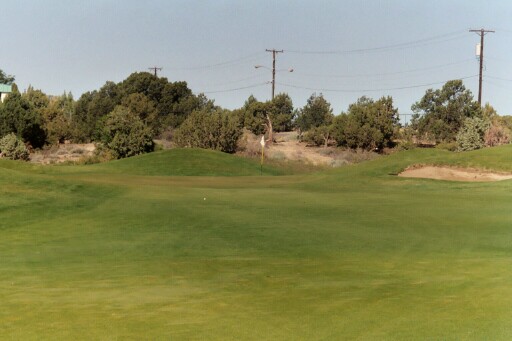
The left rear kick plate behind the original 1st green.
Other examples of holes that have lost their ‘meaning’ are the short par 5, current 13th and the short par 4, current 14th. When these holes were placed early in the round, their apparent ease helps build towards even greater shot demands needed later. Placed later in the round, as they are today, the golfer has already experienced most of the difficulty, so any intentional building of shot demands is wasted.

The short but tough two shotter 14th with an arroyo down the right and in front of the green.
Admitting that the two current finishing holes are very strong golf holes, is not really the issue. In the original configuration these holes as #8 & #9 served to further raise the bar in difficulty, as evidenced by being the #1 and #3 handicap holes, respectively. Their placement accentuated the flow of the round preparing the golfer for future demands as the course headed to its climax. The current 9th (original 18th) has every single feature that had been introduced earlier throughout the course, save for a pond. For that reason alone, it should be the finisher. Adding a long uphill climb to reach the 10th, which was never intended in the original routing, should be sufficient justification for a return to the original configuration.
The fluidity of shot demands is only part of Ken Dyes masterpiece. In the original, theres also a thoughtful flow to the overall beauty, through the use of vistas of the surrounding areas. In this original configuration the beauty also has a crescendo. By hiding the river valley, Dye slowly builds the visuals, creating a tension whose impact is felt late in the story on the original 13th, 14th and 15th holes and was appreciable.
The original 15th is the signature and anchor hole of the course. Isolated in its own canyon, this par 3 is visually stunning and unique to most golfers.
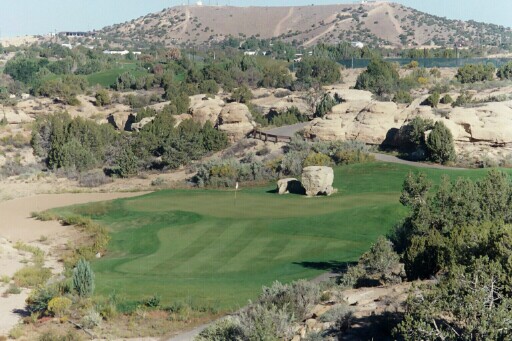
The original 15th in a river bed.
Changes to this hole were so subtle that upon moving to Farmington, and golfing Pinon Hills again, I went immediately into the pro-shop and asked ‘what did you do to the signature hole?’ The response, from those behind the counter, was a dull ‘huh?’ I had remembered the hole as having this beautiful natural wash (Arroyo) with wooden stairs leading to the top of two mesas that serve as teeing grounds. Now, after a real ‘gully washer’ transplanted most of the sand and trees down onto 30th street, there is a cart path in between the mesas and the natural wash has been forever altered with a concrete containment wall. The people in the pro-shop almost had me convinced I was nuts, or at the least, had a faulty memory, until I met Mario Ulibarri, the original superintendent. When I asked him about the canyon hole, he proudly smiled and told me he had personally dragged-in all the dead trees and hand planted many of the native plants, that had given this hole its beautiful natural look. Some readers may recall Marios presentation of this exact hole at the GCSAA convention several years ago.
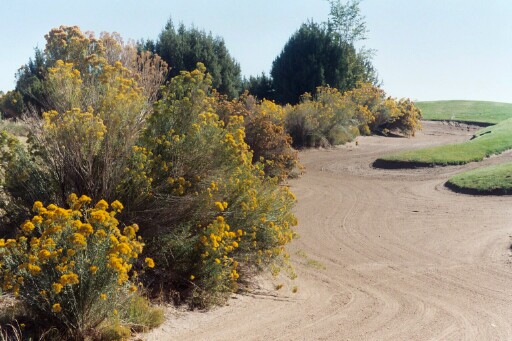
Mario Ulibarri deserves a tremendous amount of recognition for his work at Pinon Hills.
On the 7th hole theres another tragedy besides the one stemming from the configuration change. Following the signature canyon Par 3 hole, the climb to this tee, is a noticeable test on ones stamina and is part of the courses arsenal of defense. Upon initial viewing, the tee shot almost seems like a breather hole, but Ken Dye, for the first time in the round, puts the fairway bunker on the side of the fairway with the least desirable angle to the green. Further testing the golfers mental ability, there was a sandy cross wash, hidden from view located in a dip in the fairway. This sandy wash came halfway across the fairway, from the left, approximately 80 yards from the green (290ish from tee). The astute golfer should’ve appreciated the preferred angle and ease of the right side, but now, this sandy cross-wash is grassed over which allows the big hitting, non-thinking golfer to escape unscathed from what was clearly intended to be a thoughtful tee box decision, late in the round. One other justification for this sandy cross wash was that it was clearly intended to introduce the feature, as it dominates the look and strategy of the original 18th hole.

Dye built a cross bunker into this ridge but unfortunately, the bunker has since been removed.
Apart from these changes, does Pinon Hills play as Ken Dye intended?
It does in the winter. With a city manager whose position can be summed up in these words: ‘I dont care how the golf course looks as long its green’, apparently puts too much strain on the staff to maintain the course optimally. As I understand it, this dogma goes against knowledgeable advancements made in turf sciences, not to mention the lack of playability. The softness leads to the loss of certain intended features like the kick plates, such as the one on #10, the original 1st hole. Throw-in numerous ‘French Drains’, which have scarred the canvas just to move the over-watering and Id say the course is playing less and less than the way it was originally intended.
Has a hole grown on you the more you have played it at Pinon Hills?
I dont know if there is just one hole that has gained more respect or ‘grown’ on me, because every hole requires some heightened level of awareness, with execution being critical. I do find that I have a growing appreciation for many of the subtle qualities. Whether they were intended or not, I like finding something new to appreciate, for example, there’s a crisscross in the routing that until recently made little sense to me. I even went so far as to study the routing, trying to figure out where the architect went wrong. At first, I assumed it was the placement of the clubhouse and that it needed to be moved and/or was misplaced from the start. But now I appreciate the crisscross, as the only way for the visual crescendo to be achieved. The fluidity of shot demands is only part of Ken Dyes masterpiece. In the original, there’s also a thoughtful flow to the overall beauty, through the use of vistas of the surrounding areas. By hiding the river valley, Dye slowly builds the visuals, creating a tension whose impact is supposed to be felt late in the story on the original 13th, 14th and 15th holes and is appreciable.
How did Pinon Hills come to be built in Farmington? How expensive was it to build?
Ive researched old newspapers and found very little that answers ‘how’, but Ive learned through people interested in the project that after many years of ‘talk’, there finally was a vote approving a temporary tax to raise the $2.2 million needed for the project. The courses construction budget was $1.8 million and I believe the land is still owned by San Juan College. One of the more savvy politicians wanted the golf to be free, for residents, but I think the initial green fee was around $9, maybe $8.50.
Golfs origins in Farmington has a grass-roots theme. From San Juan C.C.s starting in the early 50s, as an idea from people sitting around in a coffee shop, to the El Paso Gas Companys building, for their employees, Riverview G.C. (9 holes) in nearby Kirtland, Nm., in 1954. In the early 60s the city of Farmington built Civitan G.C., a Jack Snyder designed nine-hole par 3 course. Obviously wetting their appetite for more, it took until the middle 1980s for the ball to start rolling in earnest towards Pinon Hills.
How much does it cost you to play? How about the cost for an out-of-towner?
The city sets prices and they vary according to when you book and where you live. Since I pay for an annual pass ($425.25 at Pinon Hills) I am not exactly sure on prices but I think the out of town rates are around $20. If you reserve more than 3 days in advance there is a $10/player pre-reservation fee. Carts are another $10/rider.
What are your thoughts on Paa-Ko Ridge?
Ken Dye created a venue that optimizes the magnificent vistas and rugged beauty of New Mexicos Sandia Mountain. A large planned community integrates southwestern architecture and modern golf to perfection. Through the use of natural features, like the arroyo fronting #2 green, combined with multiple teeing grounds, Ken Dye allows golfers of all levels to be challenged, and if negotiated successfully, enjoy their time spent on the property. This is to imply that errant shots are perhaps disproportionately penalized because of the rugged natural surrounds. Some containment around the greens, stymies views of terrain better left visible. Also, with greens that are less contoured than those at Pinon Hills, short game interest is minimized. Aerial assault aficionados, the average golfer and fortunate homeowners will undoubtedly be very impressed with this beautiful property.
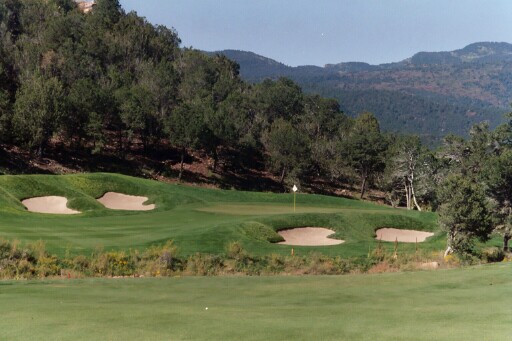
An arroyo cuts across the front of the 2nd green at Paa-Ko Ridge.
What do you think about the 4th green at Paa-Ko Ridge?
One of the great aspects Ive learned to appreciate (even more so now thanks to people plagiarizing Sheryls work) is the concept of original thought and especially as it relates to art. So, I applaud the original thought that caused this hole to become a reality. As I understand the story, the design team couldnt decide between two green locations, one upper, and one lower. With Archimedean reflection, Eureka came in the form of combining the two potential green sites into one 100-yard long green, with 13 feet of internal elevation change. While some critics view this green as quirky, goofy or just plain silly, I appreciate the effort, as well as the process, and the result is a unique memorable golf hole.
In terms of quality golf for one’s dollar, how does New Mexico stack up to other states with which you are familiar?
I suspect there are great golf values to be had in almost every state, but Id have to think New Mexico ranks pretty high for value, when comparing the price and quality to the number of courses available. Perhaps its the terrain and variety of natural features, or maybe its the states ranking in per capita income, but for whatever reason, the costs to the golfer, relative to other areas of the country, are extremely reasonable. With the addition of Black Mesa our state is well positioned to combat the future of the golf industry, wherever it should go.
What are your hopes for the future of Golf in New Mexico?
I have high hopes for land of enchantment golf and golfer. If for no other reason than the land closely resembles part of the purists definition of the word ‘links’; Land unusable for anything else. My personal hope is that more of the people will eventually and collectively catch on that a major part of this game is about handing down the spirit to those who follow, by respecting the golfer, the canvas and Mother Nature.

Today’s 9th hole at Pinon Hills highlights the beauty found in playing golf in New Mexico.
The End








